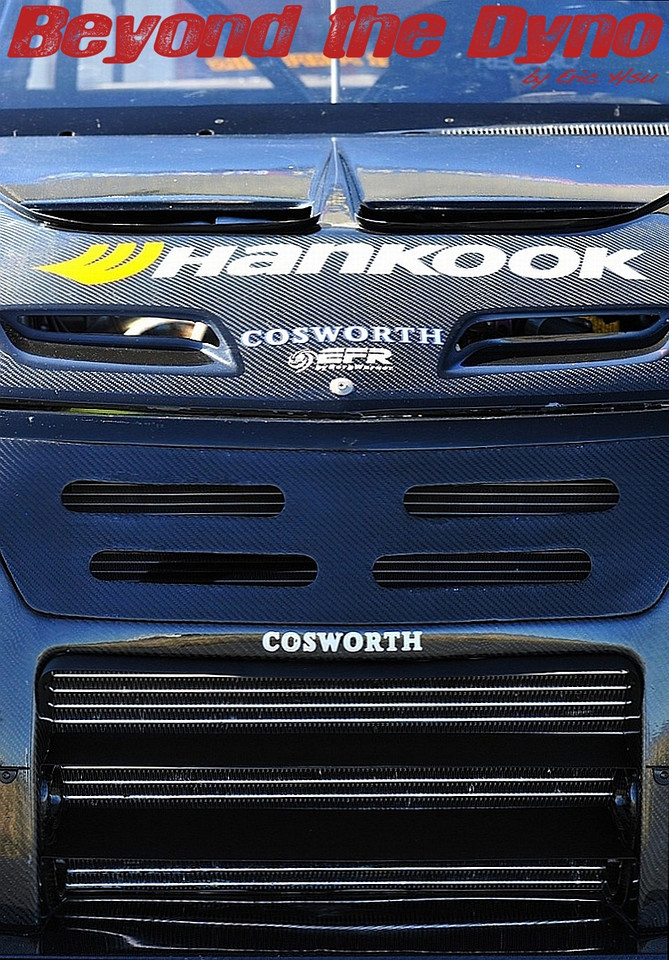
From day one the Cosworth 4G63 has always run on Royal Purple XPR 20w50. We’ve had zero lubrication related issues. In fact, most of the parts come out of the engine looking really good despite their harsh life. The film strength of Royal Purple XPR is really good. It’s so good and slimy that it’s a pain in the ass to even wash it off your hands.

My old friend Daiji at Okada Projects asked me what we were using for the ignition system. As it was I was driving the old ignition coils at the edge of saturation with the NGK Racing spark plugs at a small gap. Daiji made me an offer to test out the Okada Plasma Quad Pac coils and a version of their Plasma Lift and Plasma Booster boxes. Was it more JDM hype? Daiji promised me it wasn’t and the tests proved he wasn’t lying either.


The image on the left shows the oscilloscope trace of the typical secondary ignition current of an OEM ignition system. The image on the right shows the Okada Plasma Booster at work. In effect, the system offers a multi-strike type of spark. The Plasma Lift box works by driving the coil’s primary side at a higher voltage which is user adjustable between 13-19 volts. Now I am driving the coils at well below saturation and am able to run a larger gap at the plug at the same time. Whenever the cylinder pressures go up inside the combustion chamber, the demand for stronger spark is also raised and a stronger spark will be required to ignite the air/fuel mixture. When the spark is blown out or prevented to occur due to cylinder pressure, this causes a misfire. Misfires at 2.0 bar boost and 9000rpm are not a good thing. The abruptness of the misfire can causes extreme forces on the next cylinder that fires successfully. For the longevity of an engine, you want to prevent misfires at all costs.

The Okada Projects stuff is legit. The combination of the Plasma coils, Plasma Lift, and Plasma Booster should produce results superior to a CDI system (at any engine speed a 4G63 is capable of at least). CDI’s produce a very hot and intense, but short duration spark. The Okada system provides a very hot and intense, multi-spark, effectively long duration spark.

Mike at SSE did this ultra clean addition of an air bypass valve for rallycross style anti-lag (bang bang). Inside of this billet enclosure is essentially a high speed/high torque servo that I am able to control with the Cosworth Pectel SQ6 ECU. When Dave closes the throttle, this valve opens up an amount that I can determine with the SQ6 and a misfire, retard, and fueling strategy simulaneously triggers to produce a lot of boost before the throttle plate by driving the turbine shaft speed up with pressure in the exhaust manifold created by 1) unburned fuel ignited in the exhaust manifold during a misfire event by, 2) massive exhaust gas temperatures created by, 3) a high amount of ignition retard which is then 4) fed through the engine via boost before the throttle plate through this anti-lag valve using the two Wiggins connections and then back to step 1. The viscious cycle is effectively controlled combustion within the exhaust manifold. Of course all of this has to be done at just the right amount to create boost before the throttle plate while still maintaining a good amount of engine braking. We have not tested this on track yet due to time constraints so I’m not sure if we are going to use it or not. I guess it’s going to boil down to a matter of necessity. I’ve setup bang bang systems on rally cars, but never with a turbo of this size.

In an attempt to get more aggressive on the aero front, Mike fabricated new dive planes, aka gaynards, to maximize front grip at high speed. Pictured here are the mock ups. According to Dave, the car has always been pretty neutral which is apparently nothing like the CyberEVO. If you watch in car camera of Tarzan driving the CyberEVO, he throws that car around like it’s almost rear wheel drive. The idea to maximize front grip came up because we believe there will be a significant increase in rear downforce (keep reading).

Mike also fabricated these pockets under each side of the front splitter. My ignorance of the significance of aero does not allow me to remember the name of these pockets. I prefer engines, turbos, and electronics!

Once again I don’t know what this aero gadgetry is called, but I believe their job is to get the air out of the wheel wells (or arches for you Euro folk). These are integrated with the new floor.


